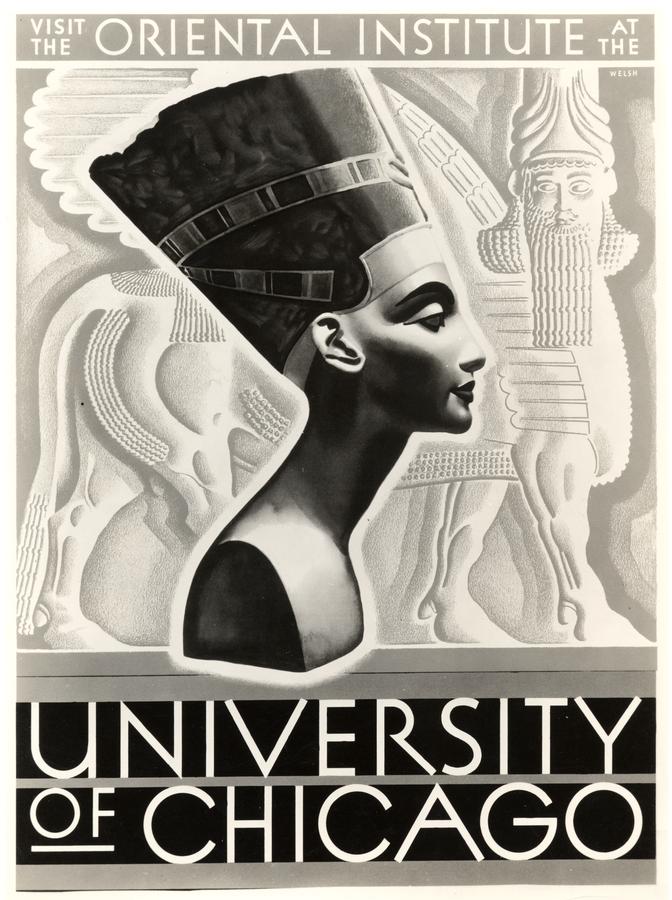James Henry Breasted encoded an epitome of his vision for the Oriental Institute in the the tympanum over its main Fifty-Eighth Street doorway. It is this relief that greets all visitors to the museum or the research projects or to other functions in the lecture hall and library.


Breasted engaged the architectural scupltor Ulric Henry Ellerhusen to realize his vision. Ellerhusen had been a student of Lorado Taft at the Art Institute of Chicago, and had already produced the integrated sculptural figures for Rockefeller Chapel in the late 1920's, in particular the series of fifteen monumental figures in the March of Religion across the front gable of the Chapel.
Breasted used the Ellerhusen design also as the motif for his bookplate. For more on this bookplate and others see Bookplates of Scholars in Ancient Studies.

In the pamphlet file of the Research Archives of the Oriental Institute there is a typescript of a document [page 1, page 2] explaining the symbolism of the design of the tympanum. This document is transcribed here, illustrated with images of artists models of the tympanum - including various alternate design versions - as well as with photographs of the tympanum as it stands today. The tympanum has been described in print in The Oriental Institute of the University of Chicago In commemoration of the dedication of the Oriental Institute building, December fifth, 1931

[Click on these photographs for higher resolution versions]
In the central motive the East is represented by an Egyptian figure of the type of Hesirë, (as shown on the wood reliefs from Saqqara). In his left hand he holds a staff; his right hand is raised in an explanatory gesture. On his shoulder hangs an Egyptian writing outfit consisting of a little vase for water and a tube for containing reed pens (both behind his shoulder), and a palette with two small recesses, one for red and one for black ink, (in front of his shoulder). The West is symbolized by a youth who reverently holds in his hands a fragment bearing the hieroglyphic words “…. We behold thy beauty.”
The figure of the East is flanked by a lion of Amenhotep III, reversed. The figure of the West, with a bison.
Above and between the two figures is a Sun Disk with the Symbol of Life and diverging rays terminating in human hands. Ancient Ruins are indicated by broken blocks in the middle, a broken capital from the Temple of Sahure, and the Step-Pyramid at Saqqara. Above the animals, outstanding figures of the Eastern and Western civilizations are shown.
The most remote figure in Eastern history (on the left), placed in upper row nearest central group, is King Zoser; followed by Hammurapi and Thutmose III. In middle row is Assurnasirpal and Darius, and in the outer left hand corner the Sassanian king Chosroes.http://www.blogger.com/img/gl.link.gif
Back of the figure of the West (on the right), in upper row nearest center, is Herodotus; with scroll, staff, and traveler’s hat. Behind Herodotus is Alexander the Great, then Emperor Augustus of Rome. In the middle row a Crusader and a Field Archaeologist. In lower right hand corner is a Museum Archaeologist examining a vase. On the left the columns of Persepolis, the Sphinx, and three pyramids in the background indicate the Art and Architecture of the East; while on the right the Parthenon, the Cathedral of Notre Dame and the Nebraska State Capitol [which at the time was the tallest building west of the Mississippi River] represent the Art and Architecture of the West.
Bosses
After Seti I in combat with Hittites (Probably Seti I, but altered).
Rows of Palms and Assyrian Soldiers; from the palace of Sennacherib.
Phoenicican Boats filed with fugitives from Assyrians; from palace of Sennacherib.
Egyptian winged sun disk; derived from Sarcophagus of Eye.
Reversed detail of Seti I, Rameses I; derived from relief at Abydos.
Two sphinxes, one of King Psamrik I and one of Hike, the god of magic; derived from Prisse d’Avennes, L’histoire de L’art égyptien, Vol. 2. Pl. 97 (Prisse’s list).
Columns Between Main Entrance Doors
Design of Capitals:
Lily of Upper Egypt
Papyrus of Lower Egypt Converted to Gothiv Form
Panel Between Columns
Derived from Assyrian pavement design.
GABLE OVER MAIN ENTRANCE
Panel
Egyptian God of Time, kneeling on the gold symbol, crowned with sun disk and uraei, holding in each hand a palm stalk calender, with a sun disk at the top. The winged sun disk crowns the whole.
Two Gothic Crockets
Details derived from papyrus motif.
PANELS AT TOP OF BUTTRESSES
(Depicting Six Oriental Civilizations)
Egypt: Two Gods of Upper and Lower Egypt knot together flowers of Upper and Lower Egypt around the Symbol of Unity; derived from the stature of Sesostris I. – Cairo.
Babylonia: The Demon Imgig and Two Lions.
Assyria: Tree of Life.
Hittites: Figure of King of Gods on Boghaz Köi Gate.
Phoenicians: Phoenician Ship from a Sidonian sarcophagus.
Hebrews: Seven-Branch Candlestick of the Hebrew from Column of Trajan.









INTERIOR
TERMINALS OF BALUSTRADE – MAIN STAIRWAY
Assyrian Lions; derived from Lion of doorway in Temple of Assur-nasir-pal at Caleh.
BRONZE GATES
Combination of Egyptian and Assyrian motifs.

PAINTED CEILINGS
Derived directly from Egyptian motifs.




Finally, here is an extraordinary alternative version of the tympanum. I can tell you nothing at all about it except that the picture of it appears, as do so many of the illustrations I have used here, in the extraordinary collection of the University of Chicago's Archival Photographic File collection.
The Archival Photographic Files (the Photofiles) comprise more than 60,000 photographs documenting the history of the University of Chicago, its campus, academic programs, and community life. The Archival Photographic Files Digitization Project is a comprehensive effort to digitize and present on the Web all of the images in the collection.I have already exploited this collection in my posting of February 15, 2008, illustrating the construction of the Oriental Institute.










 Stumble It!
Stumble It!

